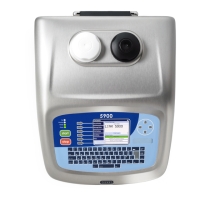Page 9 of 19 FA69386–2 English
Jun 2013
19
How To Use the Communications
Options
Linx 5900 & 7900
Print Go Mapped To/Aux Photocell Mapped To
This option controls how the standard 5900 or 7900 trigger conditions are linked to
the Print Go and Aux Photocell triggers used by the RCI protocol. The default
settings for the 5900 and 7900 printers are:
• Print Go Mapped To: Print Go
• Aux Photocell Mapped to: Leading Edge Secondary (the other options are
False, Trailing Edge Secondary, High Level Secondary Trigger, and Low Level
Secondary Trigger)
Code Page
The 5900 and 7900 printers use the Unicode character set, but the RCI protocol uses
ASCII. The Code Page option controls how the printer performs the ASCII to
Unicode translation. The available options are:
• European (4900)
• European (6200)
• European
• Japanese
• Greek
• Russian
• Polish
Select the ‘European (4900)’ option for compatibility with the 4900 printer and the
‘European (6200)’ option for compatibility with the 6200 printer. This option
contains the characters used by the 6200 printer that are not in the standard
‘European’ option.
Message Type
5900 only. This option maps the message type names used in RCI commands to the
message type names used by the printer. Select either 4900 or 5900 for compatibility
with the relevant printer.
Font
5900 only. This option maps the font information in RCI commands to the font
information used by the printer. Select either 4900 or 5900 for compatibility with the
relevant printer.
Use Checksum option
The 5900 and 7900 printers use checksums by default. To disable checksums, set
this option to ‘No’.
If checksums are disabled, the printer does not look for checksums at the end of
received data, and the accuracy of transferred data is not checked. The data can
become damaged and can cause problems in the printer and the remote host.
NOTE: The 5900 and 7900 printers do not allow changes to the settings for the
start, stop, and parity bits—they are set by default to 8 data bits, 1 start bit,
1 stop bit, and no parity.

